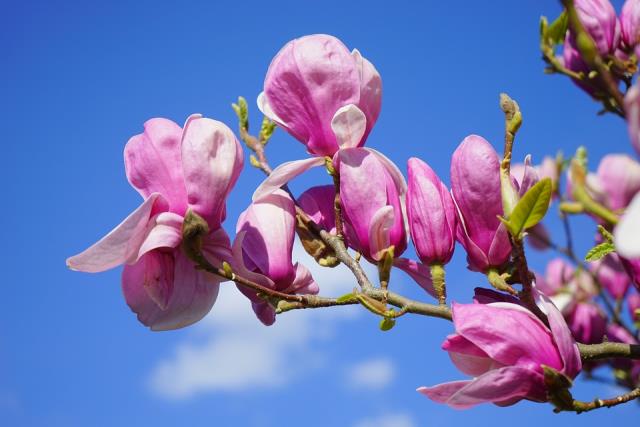By Beatrice Hawkins
In travelling the country lately I have seen many beautiful Magnolia x soulangeana trees in flower.
They are another favourite with happy associations of childhood for me. As a very small child I used to walk past a beautiful old specimen in the front yard of a very humble home. The elderly lady that lived there was an ex-school teacher and had in fact taught my father.
She had a few kerosene tins under this tree and I finally plucked up the courage to ask why. She was a dear kindly soul who took the time to explain to an inquisitive little girl how she was propagating new trees by layering.
The tins were filled with dirt and the lower limbs pinned down and covered with soil until they took root and were then cut off and she had new shrubs to plant or give away.
This lovely tree was under planted with a range of jonquils, daffodils and violets and old fashioned highly perfumed, freesias and was a garden of delight to a small girl.
Recently at the Leafmore Garden School, horticulturist and entertaining presenter Brian Samms, reminded me of this with his far more technical description for achieving the same result.
About 10 years ago I drove up the street and the tree was still there and flowering beautifully in very early spring.
These magnolias are deciduous and the beautiful goblet shaped flowers appear on the bare limbs and are then followed by the leaves. The one of my childhood was a deep burgundy but now they come in a wide range of colours.
These are commonly known as Chinese Magnolias and originate from Asia and Western China. They were brought to England in 1789 but were considered to be too “sensual” and flamboyant for conservative English gardens of the time but, these days, few large English gardens would be complete without one.
They need protection from frosts for the first few years and need protection from wind and to be well watered and mulched twice a year.
Etienne Soulange-Bodin (1774-1846) whose name is commemorated with this lovely tree was a French biologist, botanist and army officer. He was a very well educated and honoured army officer, diplomat and botanist having been awarded the Legion of Honour and Iron Cross by none other than Napoleon.
The equally beautiful, but very different, evergreen Magnolia grandiflora is native to south-eastern United States.
These spectacular, very large and long-lived trees also have happy associations for me as the large cream, lemon scented flowers were used in my mother’s horseshoe-shaped wedding bouquet in the 1930s. As a child I knew just where the tree that supplied these blooms was growing and as far as I know it is still blooming beautifully in the gardens of an historic home on the central coast of NSW. It is now a very old and very large tree having been planted in the late 1800s by an American lady who built the house.
These are the bull bay trees of the American South that you envisage when you think of plantations and Scarlet O’Hara. They can grow to be 60 to 90 feet high and 30 to 50 feet wide and live to be 80 to 120 years old given rich, moist, well-drained soil and humid conditions. Although they are native to this area of America, they were widely planted as garden specimens in the “old south”.
It is the state flower of Louisiana and the state flower and tree of Mississippi.
The dark green glossy leaves are a velvety, rusty brown on the reverse and large, at about eight inches by five inches. The flowers can be up to 12 inches across, beautifully perfumed and really spectacular.
The timber is hard, heavy and close grained and has been used as a furniture timber and for veneer.
Specimens were first taken to England by plant collector Mark Catesby in 1726.
Little Gem is a newer, smaller variety that still has the beautiful large flowers. It will tolerate most soil types from clay to sandy but prefers a slightly acidic pH, well drained and fertile. They like full sun but will tolerate some shade and need to be protected from frost when small until they are established. They will do well in large pots so long as they are well watered and fed. They are a very fashionable and popular tree for street planting and in gardens at present, if you have the room, and give form and dimension to a landscape.
Some magnolia trivia to amuse:
* Magnolia officinalis bark has been used in traditional Chinese medicine for centuries to treat anxiety and improve lung health. It may also have uses in treating Alzheimer’s disease.
* In the Disney movie “The Princess and the Frog” the character Tiana is said to be “as pretty as a magnolia in May”!
* A white magnolia with a deep red centre is the national flower of North Korea.
* A magnolia campbellii specimen growing in Clyne Gardens in Swansea is regarded as the tallest in the UK at 26 metres.
* Magnolias do not produce nectar but have protein enriched pollen that bees use as food.
* Magnolias have few pest and disease problems.
* Lastly, who can forget the cast of feisty ladies in the film “Steel Magnolias”!
*This is an old article that has been digitised so our readers have access to our full catalogue.







